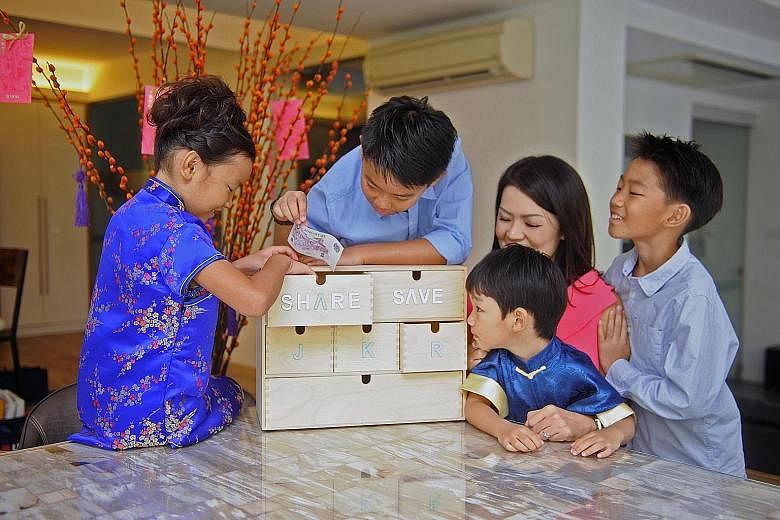Here's one family that has a unique way of saving and growing the children's money - through a "bank" run by the matriarch of the house, Ms Priscilla Ang.
Ms Ang, 40, and her husband Alex Lee, who works in the aerospace industry, have four children - Ryan, 12, Joshua, 10, Kate, eight, and Zachary, five.
Pointing to a small drawer with different compartments, Ryan explains: "Every week, Mummy gives us pocket money. We put 20 per cent in a 'save' compartment, and 10 per cent goes into 'share'.
"The money in the 'share' compartment goes towards charity or church offerings."
The "save" portion is treated like a bank deposit, where the children earn 5 per cent interest each month on the amount they have saved.
These are forced savings, and they are not allowed to take money out from that portion, unless it is for an emergency. Ms Ang has to approve the withdrawal of cash.
For instance, Ryan broke a glass picture frame as he was tossing a ball around in the house. He had to fork out $120 for a new frame, out of $200 in his "save" compartment.
Ryan understands several money concepts that his mother, a director at a technology company, has introduced to the children.
"I didn't feel that bad. You have to pay your debt and I thought Mummy would cane me, but she just asked for the $120," he says, to much laughter in the room.
The children are given free rein over the other 70 per cent which earns no interest. They can use it to buy anything they want at any time.
They can also choose to move any amount from the 70 per cent into the "save" portion, to earn more interest. This demonstrates the power of compounding interest to the children, says Ms Ang. "I chose 5 per cent a month because 5 per cent of $1 is five cents. You can't really do a per annum thing with them, as it doesn't make sense."
The children's savings are recorded in a logbook for easy reference, so that they can see how their money has grown over the months.
Kate, the only daughter in the family, is the most conscientious saver, and she saved more than $300 last year.
Ms Ang adds: "I think Kate doesn't really understand, except for the fact that her money grows. Last year, she had no mishap so she could save the most, while the rest of the boys have had to deduct money from their savings."
Allowance-wise, Ryan and Joshua get $3.50 a day, and Kate gets $2.50. Zachary does not have an allowance as he has yet to attend primary school. Ms Ang tops up their allowances when she deems fits, but notes: "The whole idea is to put them through the mechanism of saving and sharing."
Ms Ang wanted them to be familiar with the concept of money, and started the savings plan last year.
"We all know we should set aside money for emergencies, and grew up with the idea. But there was never really a structured way of doing it. I thought it would be good to instil it in the kids and I've the economies of scale here - I teach them all at once and everyone benefits."
The family also has another way of saving money, with a food fund.
Joshua says his father set up the food fund in the middle of last year because the children prefer eating in air-conditioned restaurants, compared with coffee shops.
"He wants to show us how much money we can save by not going to restaurants so often. The average restaurant bill for the family is $80 to $100. Whenever we go to a coffee shop or hawker centre, we spend about $45," says Joshua.
He explains that the sum of the difference between an average restaurant bill and what was spent at the coffee shop is put into a fund.
Ryan says: "You can buy three things with the money in the food fund - sports equipment, books and board games."
Ms Ang also takes a practical approach to their hongbao money.
Since her children started receiving hongbao during Chinese New Year, she has put their money into endowment funds, which are saving plans with insurance, for university expenses. Each child collects about $1,200 in hongbao money each year.
She says: "We didn't want to choose a risky investment for our kids. We want to make sure that at the end of the day, they have their education taken care of. There are other things in our portfolio, but where the kids are concerned, we will have this at least."
Besides saving, Ms Ang has also started to teach her children about earning one's keep the old-fashioned way, especially for big-ticket items. Kate says the family has something to save up for each year, like Taylor Swift concert tickets last year, and their year-end holiday to Japan this year. They can use money from the "save" portion, or do chores around the house.
She says: "We can water the plants, clean the pool, or go grocery shopping, for $2 for each chore. My favourite chore is baby-sitting Zach because it gives us $10. I also like teaching Zach Mandarin because it gives me $3."
Ms Ang stresses the importance of letting children learn about the value of dollars and cents early.
"I'd read in the papers where they'd say it's time to start thinking about getting your kids to understand the value of money, and that kind of triggered my plans." She wanted them to also understand that people work hard for their money, which they can choose to spend or save, and "these are some values we want them to understand".


